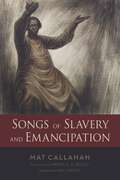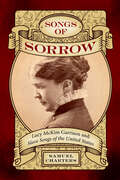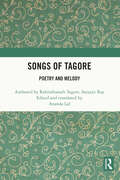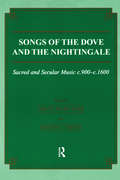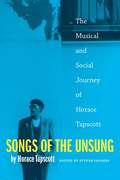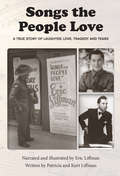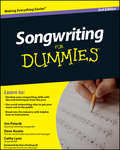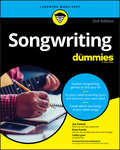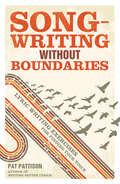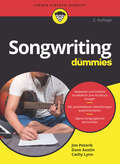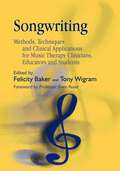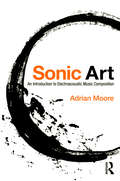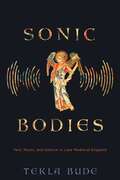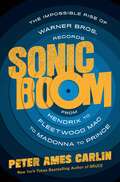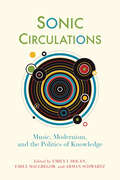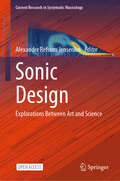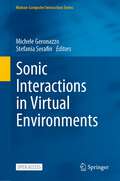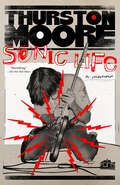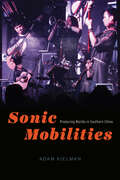- Table View
- List View
Songs of Slavery and Emancipation (Margaret Walker Alexander Series in African American Studies)
by Mat CallahanThroughout the history of slavery, enslaved people organized resistance, escape, and rebellion. Sustaining them in this struggle was their music, some examples of which are sung to this day. While the existence of slave songs, especially spirituals, is well known, their character is often misunderstood. Slave songs were not only lamentations of suffering or distractions from a life of misery. Some songs openly called for liberty and revolution, celebrating such heroes as Gabriel Prosser and Nat Turner, and, especially, celebrating the Haitian Revolution.The fight for freedom also included fugitive slaves, free Black people, and their white allies who brought forth a set of songs that were once widely disseminated but are now largely forgotten, the songs of the abolitionists. Often composed by fugitive slaves and free Black people, and first appearing in the eighteenth century, these songs continued to be written and sung until the Civil War. As the movement expanded, abolitionists even published song books used at public meetings. Mat Callahan presents recently discovered songs composed by enslaved people explicitly calling for resistance to slavery, some originating as early as 1784 and others as late as the Civil War. He also presents long-lost songs of the abolitionist movement, some written by fugitive slaves and free Black people, challenging common misconceptions of abolitionism. Songs of Slavery and Emancipation features the lyrics of fifteen slave songs and fifteen abolitionist songs, placing them in proper historical context and making them available again to the general public. These songs not only express outrage at slavery but call for militant resistance and destruction of the slave system. There can be no doubt as to their purpose: the abolition of slavery, the emancipation of African American people, and a clear and undeniable demand for equality and justice for all humanity.
Songs of Sorrow: Lucy McKim Garrison and Slave Songs of the United States (American Made Music Series)
by Samuel ChartersIn the spring of 1862, Lucy McKim, the nineteen-year-old daughter of a Philadelphia abolitionist Quaker family, traveled with her father to the Sea Islands of South Carolina to aid him in his efforts to organize humanitarian aid for thousands of newly freed slaves. During her stay she heard the singing of the slaves in their churches, as they rowed their boats from island to island, and as they worked and played. Already a skilled musician, she determined to preserve as much of the music as she could, quickly writing down words and melodies, some of them only fleeting improvisations. Upon her return to Philadelphia, she began composing musical settings for the songs and in the fall of 1862 published the first serious musical arrangements of slave songs. She also wrote about the musical characteristics of slave songs, and published, in a leading musical journal of the time, the first article to discuss what she had witnessed. In Songs of Sorrow: Lucy McKim Garrison and “Slave Songs of the United States,” renowned music scholar Samuel Charters tells McKim's personal story. Letters reveal the story of young women's lives during the harsh years of the war. At the same time that her arrangements of the songs were being published, a man with whom she had an unofficial “attachment” was killed in battle, and the war forced her to temporarily abandon her work. In 1865 she married Wendell Phillips Garrison, son of abolitionist William Lloyd Garrison, and in the early months of their marriage she proposed that they turn to the collection of slave songs that had long been her dream. She and her husband—a founder and literary editor of the recently launched journal The Nation—enlisted the help of two associates who had also collected songs in the Sea Islands. Their book, Slave Songs of the United States, appeared in 1867. After a long illness, ultimately ending in paralysis, she died at the age of thirty-four in 1877. This book reclaims the story of a pioneer in ethnomusicology, one whose influential work affected the Fisk Jubilee Singers and many others.
Songs of Tagore: Poetry and Melody
by Rabindranath Tagore Satyajit RayRabindranath Tagore composed over 2000 songs that are revered and sung by Bengalis everywhere. However, they remain mostly unknown to listeners from other communities. This book brings the Nobel Laureate’s unique music — Rabindrasangit — to a global audience, with a lucid introduction by Ananda Lal as well as selected songs in international transcription and English translation. It includes an essay written originally in Bengali by the celebrated filmmaker Satyajit Ray, himself a Tagore student and music composer. Ray presents his thoughts on Rabindrasangit, its nuances, music, history, and usage. Lal has also translated this essay into English for the first time. The book also presents for the first time faithful staff notations of all 41 songs in three of Tagore’s major plays — Rakta-karavi, Tapati, and Arup Ratan — providing a thematic unity to the music section. This volume will be of interest to Tagore and Ray enthusiasts and specialists, musicologists, and students of music, theatre, literature, performance studies, and cultural studies. It will appeal not only to scholars but to general readers wanting to know more about Tagore’s songs, as well as directors, arrangers, composers, and singers who may wish to perform or interpret the songs transcribed.
Songs of the Dove and the Nightingale: Sacred and Secular Music c.900-c.1600 (Musicology #17)
by Greta Mary Hair Robyn E. SmithFirst Published in 1995. Routledge is an imprint of Taylor & Francis, an informa company.
Songs of the Factory: Pop Music, Culture, and Resistance
by Marek KorczynskiIn Songs of the Factory, Marek Korczynski examines the role that popular music plays in workers' culture on the factory floor. Reporting on his ethnographic fieldwork in a British factory that manufactures window blinds, Korczynski shows how workers make often-grueling assembly-line work tolerable by permeating their workday with pop music on the radio. The first ethnographic study of musical culture in an industrial workplace, Songs of the Factory draws on socio-musicology, cultural studies, and sociology of work, combining theoretical development, methodological innovation, and a vitality that brings the musical culture of the factory workers to life. Music, Korczynski argues, allows workers both to fulfill their social roles in a regimented industrial environment and to express a sense of resistance to this social order. The author highlights the extensive forms of informal collective resistance within this factory, and argues that the musically informed culture played a key role in sustaining these collective acts of resistance. As well as providing a rich picture of the musical culture and associated forms of resistance in the factory, Korczynski also puts forward new theoretical concepts that have currency in other workplaces and in other rationalized spheres of society.
Songs of the Unsung: The Musical and Social Journey of Horace Tapscott
by Horace TapscottSongs of the Unsung is the autobiography of Los Angeles jazz musician and activist Horace Tapscott (1934-1999). A pianist who ardently believed in the power of music to connect people, Tapscott was a beloved and influential character who touched many yet has remained unknown to the majority of Americans. In addition to being "his" story, Songs of the Unsung is the story of Los Angeles's cultural and political evolution over the last half of the twentieth century, of the origins of many of the most important avant-garde musicians still on the scene today, and of a rich and varied body of music. Tapscott's narrative covers his early life in segregated Houston, his move to California in 1943, life as a player in the Air Force band in the early fifties, and his travels with the Lionel Hampton Band. He reflects on how the Pan Afrikan Peoples Arkestra (the "Ark"), an organization he founded in 1961 to preserve and spread African and African-American music, eventually became the Union of God's Musicians and Artists Ascension--a group that not only performed musically but was active in the civil rights movement, youth education, and community programs. Songs of the Unsung also includes Tapscott's vivid descriptions of the Watts neighborhood insurrection of 1965 and the L. A. upheavals of 1992, interactions with both the Black Panthers and the L. A. P. D. , his involvement in Motown's West Coast scene, the growth of his musical reputation abroad, and stories about many of his musician-activist friends, including Billy Higgins, Don Cherry, Buddy Collette, Arthur Blythe, Lawrence and Wilber Morris, Linda Hill, Elaine Brown, Stanley Crouch, and Sun Ra. With a foreword by Steven Isoardi, a brief introduction by actor William Marshall, a full discography of Tapscott's recordings, and many fine photographs, Songs of the Unsung is the inspiring story of one of America's most unassuming twentieth-century heroes.
Songs the People Love
by Kurt Liffman Patricia LiffmanAt the start of World War II, Eric Liffman, a refugee from Nazi Germany, is imprisoned and transported from London to Australia on the infamous troop ship HMT Dunera. After imprisonment in Hay and Tatura, he, in a strange twist of fate, is invited to join the Australian Army, whereupon he restarts his musical career as a gifted tenor and becomes a celebrity performing to packed concert halls and raising large sums of money for the war effort. After the war, he returns to Germany to search for surviving members of his family. A unique account of wartime London, Melbourne, pre and post war Germany from a refugee/prisoner, who became the most celebrated tenor in Australia during the Second World War.
Songwriters of the American Musical Theatre: A Style Guide for Singers
by Nathan HurwitzFrom the favorites of Tin Pan Alley to today’s international blockbusters, the stylistic range required of a musical theatre performer is expansive. Musical theatre roles require the ability to adapt to a panoply of characters and vocal styles. By breaking down these styles and exploring the output of the great composers, Songwriters of the American Musical Theatre offers singers and performers an essential guide to the modern musical. Composers from Gilbert and Sullivan and Irving Berlin to Alain Boublil and Andrew Lloyd Webber are examined through a brief biography, a stylistic overview, and a comprehensive song list with notes on suitable voice types and further reading. This volume runs the gamut of modern musical theatre, from English light opera through the American Golden Age, up to the "mega musicals" of the late Twentieth Century, giving today’s students and performers an indispensable survey of their craft.
Songwriting For Dummies
by Dave Austin Jim Peterik Cathy LynnProven techniques for songwriting successThis friendly, hands-on guide tackles the new face of the recording industry, guiding you through the shift from traditional sales to downloads and mobile music, as well as how you can harness social media networks to get your music "out there." You get basic songwriting concepts, insider tips and advice, and inspiration for writing -- and selling -- meaningful, timeless songs.Songwriting 101 -- get a grip on everything you need to know to write a song, from learning to listen to your "inner voice" to creating a "mood" and everything in betweenJaunt around the genres -- discover the variety of musical genres and find your fit, whether it's rock, pop, R&B, gospel, country, or moreLet the lyrics out -- master the art of writing lyrics, from finding your own voice to penning the actual words to using hooks, verses, choruses, and bridgesMake beautiful music -- find your rhythm, make melodies, and use chords to put the finishing touches on your songWork the Web -- harness online marketing and social networks like Facebook, Twitter, and others to get your music heard by a whole new audienceOpen the book and find:What you need to know before you write a single noteTips on finding inspirationWays to use poetic devices in lyricsComputer and Web-based shortcuts and technologies to streamline songwritingA look at famous songwriting collaboratorsWriting for stage, screen, and televisionHow to make a demo to get your song heardAdvice on how to make money from your musicLearn to:Develop your songwriting skills with tips and techniques from the prosUse social networking sites to get your music out to the publicBreak into the industry with helpful, how-to instructions
Songwriting For Dummies (For Dummies Ser.)
by Dave Austin Jim Peterik Cathy Lynn AustinProven techniques for songwriting success This friendly, hands-on guide tackles the new face of the recording industry, guiding you through the shift from traditional sales to downloads and mobile music, as well as how you can harness social media networks to get your music "out there." You get basic songwriting concepts, insider tips and advice, and inspiration for writing — and selling — meaningful, timeless songs. Songwriting 101 — get a grip on everything you need to know to write a song, from learning to listen to your "inner voice" to creating a "mood" and everything in between Jaunt around the genres — discover the variety of musical genres and find your fit, whether it's rock, pop, R&B, gospel, country, or more Let the lyrics out — master the art of writing lyrics, from finding your own voice to penning the actual words to using hooks, verses, choruses, and bridges Make beautiful music — find your rhythm, make melodies, and use chords to put the finishing touches on your song Work the Web — harness online marketing and social networks like Facebook, Twitter, and others to get your music heard by a whole new audience Open the book and find: What you need to know before you write a single note Tips on finding inspiration Ways to use poetic devices in lyrics Computer and Web-based shortcuts and technologies to streamline songwriting A look at famous songwriting collaborators Writing for stage, screen, and television How to make a demo to get your song heard Advice on how to make money from your music Songwriting For Dummies, 2nd Edition (9781119675655) was previously published as Songwriting For Dummies, 2nd Edition (9780470615140). While this version features a new Dummies cover and design, the content is the same as the prior release and should not be considered a new or updated product.
Songwriting Without Boundaries: Lyric Writing Exercises for Finding Your Voice
by Pat PattisonInfuse your lyrics with sensory detail!Writing great song lyrics requires practice and discipline. Songwriting Without Boundaries will help you commit to routine practice through fun writing exercises. This unique collection of more than150 sense-bound prompts helps you develop the skills you need to: • tap into your senses and inject your writing with vivid details • effectively use metaphor and comparative language • add rhythm to your writing and manage phrasingSongwriters, as well as writers of other genres, will benefit from this collection of sensory writing challenges. Divided into four sections, Songwriting Without Boundaries features four different fourteen-day challenges with timed writing exercises, along with examples from other songwriters, poets, and prose writers.
Songwriting für Dummies (Für Dummies)
by Dave Austin Jim Peterik Cathy LynnVon der Song-Idee zur Hitsingle: In diesem Buch finden Sie alles, was Sie wissen müssen, um mit Ihrem Song in der Musikindustrie Erfolg zu haben. Finden Sie den Stil, Rhythmus und Reim, der zu Ihrem Genre passt, und fesseln Sie Ihre Zuhörer mit eingängigen Texten und unvergesslichen Melodien. Mit vielen Übungen und Beispielen unterstützen die Autoren Sie bei den grundlegenden, kreativen Elementen des Songwriting, aber auch bei dem, was danach kommt: Demotape, Online-Marketing, digitale Downloads, Urheberrecht, Verträge, Agenten und Plattenfirmen - so lernen Sie, wie Sie mit Ihren Werken die größten Erfolge erzielen können.
Songwriting: Methods, Techniques and Clinical Applications for Music Therapy Clinicians, Educators and Students
by Felicity Baker Tony Wigram Amelia Oldfield Jeanette Tamplin Jeanette Kennelly Lucanne Magill Emma DaviesThis comprehensive and groundbreaking book describes the effective use of songwriting in music therapy with a variety of client populations, from children with cancer and adolescents in secondary school to people with traumatic brain injury and mental health problems. The authors explain the specific considerations to bear in mind when working with particular client groups to achieve the best clinical outcomes. All the contributors are experienced music therapy clinicians and researchers. They provide many case examples from clinical practice to illustrate the therapeutic methods being used, together with notated examples of songs produced in therapy. Particular emphasis is placed on how lyrics and music are created, including the theoretical approaches underpinning this process. This practical book will prove indispensable to students, clinical therapists, music therapists, educators, teachers and musicians.
Sonic Art: An Introduction to Electroacoustic Music Composition
by Adrian MooreWritten by an active composer, performer and educator, Sonic Art: An Introduction to Electroacoustic Music Composition provides a clear and informative introduction to the compositional techniques behind electroacoustic music. It brings together theory, aesthetics, context and practical applications to allow students to start thinking about sound creatively, and gives them the tools to compose meaningful sonic art works. In addition to explaining the techniques and philosophies of sonic art, the book examines over forty composers and their works, introducing the history and context of notable pieces, and includes chapters on how to present compositions professionally, in performance and online. The book is supported by an online software toolkit which enables readers to start creating their own compositions. Encouraging a ‘hands on’ approach to working with sound, Sonic Art is the perfect introduction for anyone interested in electroacoustic music and crafting art from sounds.
Sonic Bodies: Text, Music, and Silence in Late Medieval England (Sound in History)
by Tekla BudeWhat is the body when it performs music? And what, conversely, is music as it reverberates through or pours out of a performing body? Tekla Bude starts from a simple premise—that music requires a body to perform it—to rethink the relationship between music, matter, and the body in the late medieval period.Progressing by way of a series of case studies of texts by Richard Rolle, Walter Hilton, Margery Kempe, Geoffrey Chaucer, William Langland, and others, Bude argues that writers thought of "music" and "the body" not as separate objects or ontologically prior categories, but as mutually dependent and historically determined processes that called each other into being in complex and shifting ways. For Bude, these "sonic bodies" are often unexpected, peculiar, even bizarre, and challenge our understanding of their constitutive parts.Building on recent conversations about embodiment and the voice in literary criticism and music theory, Sonic Bodies makes two major interventions across these fields: first, it broadens the definitional ambits and functions of both "music" and "the body" in the medieval period; and second, it demonstrates how embodiment and musicality are deeply and multiply intertwined in medieval writing. Compelling literary subjects, Bude argues, are literally built out of musical situations.
Sonic Boom: The Impossible Rise of Warner Bros. Records, from Hendrix to Fleetwood Mac to Madonna to Prince
by Peter Ames CarlinFrom journalist Peter Ames Carlin—the New York Times bestselling music biographer who chronicled the lives and careers of Paul McCartney, Bruce Springsteen, the Beach Boys, and Paul Simon—Sonic Boom captures the rollicking story of the most successful record label in the history of rock and roll, Warner Bros Records, and the remarkable secret to its meteoric rise.The roster of Warner Brothers Records and its subsidiary labels reads like the roster of the Rock & Roll Hall of Fame: Jimi Hendrix, the Grateful Dead, Joni Mitchell, Neil Young, James Taylor, Fleetwood Mac, the Eagles, Prince, Van Halen, Madonna, Tom Petty, R.E.M., Red Hot Chili Peppers, and dozens of others. But the most compelling figures in the Warner Bros. story are the sagacious Mo Ostin and the unlikely crew of hippies, eccentrics, and enlightened execs who were the first in the music business to read the generational writing on the wall in the mid-1960s. By recruiting outsider artists and allowing them to make the music they wanted, Ostin and his staff transformed an out-of-touch company into the voice of a generation. Along the way, they revolutionized the music industry and, within just a few years, created the most successful record label in the history of the American music industry.How did they do it? It all goes back to the day in 1967 when the newly tapped label president Mo Ostin called his team together to share his grand strategy for the struggling company: “We need to stop trying to make hit records. Let’s just make good records and turn those into hits.”With that, Ostin ushered in a counterintuitive model that matched the counterculture. His offbeat crew reinvented the way business was done, giving their artists free rein while rejecting out-of-date methods of advertising, promotion, and distribution. And even as they set new standards for in-house weirdness, the upstarts’ experiments and innovations paid off, to the tune of hundreds of legendary hit albums.It may sound like a fairy tale, but once upon a time Warner Bros Records conquered the music business by focusing on the music rather than the business. Their story is as raucous as it is inspiring, pure entertainment that also maps a route to that holy grail: love and money.Includes black-and-white photographs
Sonic Circulations: Music, Modernism, and the Politics of Knowledge (Sound in History)
by Edited by Emily I. Dolan, Emily MacGregor, and Arman SchwartzThe role music, sound, and voice played in modern knowledge production in the early twentieth centuryDerived from the Latin words circum (round) and ire (to go), a circuit can refer to any bounded area. For contemporary readers, it might evoke the course of an electric current, as well as the flow of global capital. Yet sound—an inherently temporal phenomenon—can only circulate in mediated forms. Tracing the pathways through and by which sound traveled in the early twentieth century, Sonic Circulations not only proposes a new account of the role of music, sound, and voice in modern knowledge production but also poses urgent questions about technology and empire, while also foregrounding the tensions and paradoxes involved in situating the sonic within any fixed regime or system.Exploring key moments in the development of disciplines including linguistics, sociology, and eugenics, as well as musicology itself, Sonic Circulations explores the many ways that sound has functioned as evidence and information, as both an object and an agent of scientific mastery. Contributors explore the processes by which sound has moved through a variety of conceptual, as well as physical domains, highlighting the richness of historical contingency. This volume shows that circulation happened in many spaces and through many technologies: through sound recording, but also through the trade magazine and in the classroom; through wireless broadcasting and international festivals, but also in the cozy spaces of the suburban home.Featuring scholars working at the borders of musicology, ethnomusicology, sound studies, and music theory, this volume’s ten chapters and two epilogues illuminate an alternative genealogy of modernism, emphasizing the embeddedness of even the most abstract practices in the structures of imperial modernity.Contributors: Peter Asimov, Andrea F. Bohlman, Harriet Boyd-Bennett, Alexander W. Cowan, Emily I. Dolan, John Gabriel, Jonathan Hicks, Alexandra Kieffer, Gundula Kreuzer, Deirdre Loughridge, Emily MacGregor, Giles Masters, Arman Schwartz, Danielle Simon, John Tresch.
Sonic Design: Explorations Between Art and Science (Current Research in Systematic Musicology #12)
by Alexander Refsum JenseniusThis open access book offers a historical context and an overview of the field's current artistic and scientific research. Sonic design includes the construction and performance of acoustic instruments but also recording, editing, mixing, and synthesizing sounds using analog and digital electronic devices. This book explores sonic design from the perspectives of music theory, music perception, embodied cognition, phenomenology, soundscape studies, acoustics, new interfaces for musical expression, sound and music computing, and music information retrieval. The chapters are selected contributions from an international seminar organized to celebrate the achievements of Professor Rolf Inge Godøy at the University of Oslo. As a composer, researcher, teacher, and supervisor, Professor Godøy has been central in developing a holistic approach to sonic design, from theory to practice. This book offers a comprehensive overview of the field's current state, making it essential reading for students, practitioners, and researchers across a wide range of disciplines.
Sonic Experience
by Henri Torgue Jean-François AugoyardIn a multidisciplinary work spanning musicology, electro-acoustic composition, architecture, urban studies, communication, phenomenology, social theory, physics, and psychology, Jean-François Augoyard, Henry Torgue, and their associates at the Centre for Research on Sonic Space and the Urban Environment (CRESSON) in Grenoble, France, provide an alphabetical sourcebook of eighty sonic/auditory effects. Their accounts of sonic effects such as echo, anticipation, vibrato, and wha-wha integrate information about the objective physical spaces in which sounds occur with cultural contexts and individual auditory experience. Sonic Experience attempts to rehabilitate general acoustic awareness, combining accessible definitions and literary examples with more in-depth technical information for specialists.
Sonic Experience: A Guide to Everyday Sounds
by Henri Torgue Jean-François AugoyardIn a multidisciplinary work spanning musicology, electro-acoustic composition, architecture, urban studies, communication, phenomenology, social theory, physics, and psychology, Jean-François Augoyard, Henry Torgue, and their associates at the Centre for Research on Sonic Space and the Urban Environment (CRESSON) in Grenoble, France, provide an alphabetical sourcebook of eighty sonic/auditory effects. Their accounts of sonic effects such as echo, anticipation, vibrato, and wha-wha integrate information about the objective physical spaces in which sounds occur with cultural contexts and individual auditory experience. Sonic Experience attempts to rehabilitate general acoustic awareness, combining accessible definitions and literary examples with more in-depth technical information for specialists.
Sonic Flux: Sound, Art, and Metaphysics
by Christoph CoxFrom Edison’s invention of the phonograph through contemporary field recording and sound installation, artists have become attracted to those domains against which music has always defined itself: noise, silence, and environmental sound. Christoph Cox argues that these developments in the sonic arts are not only aesthetically but also philosophically significant, revealing sound to be a continuous material flow to which human expressions contribute but which precedes and exceeds those expressions. Cox shows how, over the course of the twentieth and twenty-first centuries, philosophers and sonic artists have explored this “sonic flux.” Through the philosophical analysis of works by John Cage, Maryanne Amacher, Max Neuhaus, Christian Marclay, and many others, Sonic Flux contributes to the development of a materialist metaphysics and poses a challenge to the prevailing positions in cultural theory, proposing a realist and materialist aesthetics able to account not only for sonic art but for artistic production in general.
Sonic Interactions in Virtual Environments (Human–Computer Interaction Series)
by Stefania Serafin Michele GeronazzoThis open access book tackles the design of 3D spatial interactions in an audio-centered and audio-first perspective, providing the fundamental notions related to the creation and evaluation of immersive sonic experiences. The key elements that enhance the sensation of place in a virtual environment (VE) are:Immersive audio: the computational aspects of the acoustical-space properties of Virutal Reality (VR) technologies Sonic interaction: the human-computer interplay through auditory feedback in VEVR systems: naturally support multimodal integration, impacting different application domainsSonic Interactions in Virtual Environments will feature state-of-the-art research on real-time auralization, sonic interaction design in VR, quality of the experience in multimodal scenarios, and applications. Contributors and editors include interdisciplinary experts from the fields of computer science, engineering, acoustics, psychology, design, humanities, and beyond. Their mission is to shape an emerging new field of study at the intersection of sonic interaction design and immersive media, embracing an archipelago of existing research spread in different audio communities and to increase among the VR communities, researchers, and practitioners, the awareness of the importance of sonic elements when designing immersive environments.
Sonic Life: A Memoir
by Thurston MooreFrom the founding member of Sonic Youth, a passionate memoir tracing the author's life and art—from his teen years as a music obsessive in small-town Connecticut, to the formation of his legendary rock group, to thirty years of creation, experimentation, and wonder"Downtown scientists rejoice! For Thurston Moore has unearthed the missing links, the sacred texts, the forgotten stories, and the secret maps of the lost golden age. This is history—scuffed, slightly bent, plenty noisy, and indispensable." —Colson Whitehead, Pulitzer Prize–winning author of The Underground Railroad and Harlem Shuffle Thurston Moore moved to Manhattan&’s East Village in 1978 with a yearning for music. He wanted to be immersed in downtown New York&’s sights and sounds—the feral energy of its nightclubs, the angular roar of its bands, the magnetic personalities within its orbit. But more than anything, he wanted to make music—to create indelible sounds that would move, provoke, and inspire.His dream came to life in 1981 with the formation of Sonic Youth, a band Moore cofounded with Kim Gordon and Lee Ranaldo. Sonic Youth became a fixture in New York&’s burgeoning No Wave scene—an avant-garde collision of art and sound, poetry and punk. The band would evolve from critical darlings to commercial heavyweights, headlining festivals around the globe while helping introduce listeners to such artists as Nirvana, Hole, and Pavement, and playing alongside such icons as Neil Young and Iggy Pop. Through it all, Moore maintained an unwavering love of music: the new, the unheralded, the challenging, the irresistible.In the spirit of Just Kids, Sonic Life offers a window into the trajectory of a celebrated artist and a tribute to an era of explosive creativity. It presents a firsthand account of New York in a defining cultural moment, a history of alternative rock as it was birthed and came to dominate airwaves, and a love letter to music, whatever the form. This is a story for anyone who has ever felt touched by sound—who knows the way the right song at the right moment can change the course of a life.
Sonic Mobilities: Producing Worlds in Southern China (Chicago Studies in Ethnomusicology)
by Adam KielmanA fascinating look at how the popular musical culture of Guangzhou expresses the city’s unique cosmopolitanism. Guangzhou is a large Chinese city like many others. With a booming economy and abundant job opportunities, it has become a magnet for rural citizens seeking better job prospects as well as global corporations hoping to gain a foothold in one of the world’s largest economies. This openness and energy have led to a thriving popular music scene that is every bit the equal of Beijing’s. But the musical culture of Guangzhou expresses the city’s unique cosmopolitanism. A port city that once played a key role in China’s maritime Silk Road, Guangzhou has long been an international hub. Now, new migrants to the city are incorporating diverse Chinese folk traditions into the musical tapestry. In Sonic Mobilities, ethnomusicologist Adam Kielman takes a deep dive into Guangzhou's music scene through two bands, Wanju Chuanzhang (Toy Captain) and Mabang (Caravan), that express ties to their rural homelands and small-town roots while forging new cosmopolitan musical connections. These bands make music that captures the intersection of the global and local that has come to define Guangzhou, for example by writing songs with a popular Jamaican reggae beat and lyrics in their distinct regional dialects mostly incomprehensible to their audiences. These bands create a sound both instantly recognizable and totally foreign, international and hyper-local. This juxtaposition, Kielman argues, is an apt expression of the demographic, geographic, and political shifts underway in Guangzhou and across the country. Bridging ethnomusicology, popular music studies, cultural geography, and media studies, Kielman examines the cultural dimensions of shifts in conceptualizations of self, space, publics, and state in a rapidly transforming the People’s Republic of China.
Sonic Rebellions: Sound and Social Justice
by Wanda CantonSonic Rebellions combines theory and practice to consider contemporary uses of sound in the context of politics, philosophy, and protest, by exploring the relationship between sound and social justice, with particular attention to sonic methodologies not necessarily conceptualised or practiced in traditional understandings of activism.An edited collection written by artists, academics, and activists, many of the authors have multidimensional experiences as practitioners themselves, and readers will benefit from never-before published doctoral and community projects, and innovative, audio-based interpretations of social issues today. Chapters cover the use of soundscapes, rap, theatre, social media, protest, and song, in application to contemporary socio-political issues, such as gentrification, neoliberalism, criminalisation, democracy, and migrant rights. Sonic Rebellions looks to encourage readers to become, or consider how they are, Sonic Rebels themselves, by developing their own practices and reflections in tandem to continue the conversation as to how sound permeates our sociopolitical lives.This is an essential resource for those interested in how sound can change the world, including undergraduates and postgraduates from across the social sciences and humanities, scholars and instructors of sound studies and sound production, as well as activists, artists, and community organisers.
